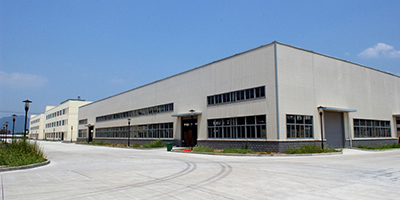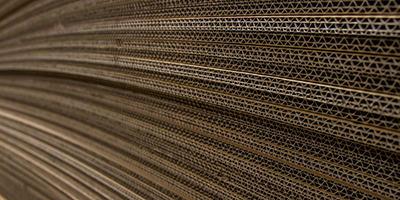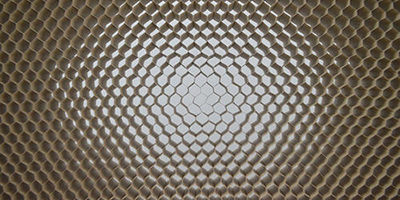






New environmentally friendly furniture material-honeycomb composite material
With the rapid development of my country's economy, the demand for wood materials has also increased significantly, mainly in the fields of construction, furniture, packaging and papermaking. According to statistics, my country's timber imports in 2003 were about 123.16 million m3, and they are still on the rise. In 2003, the import of logs, sawn timber, wood-based panels, wood pulp and paper and paperboard consumed about 13 billion U.S. dollars, which is equivalent to more than 100 billion yuan. It is the third largest foreign exchange product after petroleum and steel. It can be seen that there is a shortage of wood.
The application of honeycomb composite materials was born. It is a new type of material with light weight, high strength and high rigidity. It has the functions of buffering, shock isolation, heat preservation, heat insulation and sound insulation. It is widely used in the construction industry, vehicle and ship manufacturing, furniture manufacturing, packaging and transportation industries. , Instead of wood, clay bricks and high foamed polystyrene, it has high economic value and can be recycled; at the same time, it can save a lot of forest resources, protect and improve the ecological environment. It is a new type of environmental protection that conforms to the development theme of the 21st century. material.
1. The origin of honeycomb paper
Scientists have discovered that the hexagonal hexahedral nest made by bees is a masterpiece. It uses the least amount of material to construct a very strong honeycomb. Its structure is stronger than any other shape. Because of the arrangement of multiple walls and a series of continuous honeycomb-shaped net-like structures, the external forces from all parties can be dispersed, making the honeycomb structure's resistance to squeezing force much higher than that of any round or square. Scientists' research on honeycomb structure gives people the enlightenment that even a very thin material, as long as it is made into a honeycomb shape, it can withstand a lot of pressure. It was inspired by the honeycomb that honeycomb structural materials began to appear.
Honeycomb panels are generally divided into two categories: metal and non-metal. Metal honeycomb panels are mainly used in aircraft manufacturing, steam turbine manufacturing, shipbuilding, and transportation industries. Non-metal honeycomb panels are divided into fiber and paper. Fiber honeycomb panels are mainly used in transportation, interior decoration, and furniture industries; paper honeycomb panels are mainly used in packaging, building materials, and furniture industries. The paper honeycomb board used in the packaging industry, namely honeycomb cardboard, is mainly used to make packing boxes and transport packaging.
2. The forming theory of honeycomb paper core
The forming principle of the honeycomb paper core can be illustrated by a simple small experiment.
First, on one side of a piece of paper along the vertical direction of the length of the paper, apply a number of equal glue lines with pitch (T), width (B), and the pitch is 4 times the width of the glue line, T= "4B, we also apply the same glue line on another strip of paper, and then displace the two strips of paper together to form a regular hexagonal honeycomb structure.
As for the misalignment adhesive compounding, the glue line of the second piece of paper is accurately glued on the opposite side of the center of the distance between the two glue lines of the first piece of paper (as shown in Figure 1), when several pieces of paper are glued in this way. At the same time, stretch the strip of paper horizontally until it is even, so that several regular hexagons are formed.
When the width and pitch of the glue line are changed (T≠4B), the honeycomb will become a honeycomb of other shapes. When the hole diameter, that is, the diameter of the inscribed circle of the honeycomb is changed, different types of honeycomb paper cores can be obtained. In the actual production process, the paper core with large honeycomb aperture is generally easy to stretch, and the production speed can also be increased, but the strength is lower. Generally, in the production of honeycomb pallets, B-type (inner diameter of 15mm) and C-type (inner diameter of 20mm) honeycomb paper cores are used, and B-type (inner diameter of 15mm) is mostly used in furniture.
3. Application status of honeycomb composite materials
3.1 First use in aerospace
The honeycomb structure material originated from bionics and was first used in the aerospace field. It is an ultra-light composite material developed in response to the special needs of aerospace science and technology. From the earliest hexagonal aluminum honeycomb core used to manufacture the sandwich structure of aircraft in the 1930s, to the first use of non-metal honeycomb composite panels as the floor of the aircraft in the Boeing747 aircraft of Boeing in the 1970s, honeycomb composite materials have been used today. It is widely used in aerospace vehicles such as airplanes, rockets and space ships.
3.2 Application of honeycomb composite materials in construction and furniture
3.2.1 Use in construction
For civilian use, honeycomb composite board is a composite board made of thin man-made board, cardboard and recycled paper honeycomb core. It is very suitable for interlayer material, such as honeycomb composite light-weight wall, the honeycomb core material only accounts for about 1 to 5% of the solid material. For example, the patented product QD-SXZ honeycomb gypsum board (patent number ZL002164000, won the Shanghai Science and Technology Achievement Award.), is a new type of lightweight, heat preservation, heat insulation, sound insulation, flame retardant, non-toxic and easy to install. Construction and decoration materials can be widely used in construction, decoration, storage, transportation, transportation, agriculture, film and television props and other fields. In the West, honeycomb composite panels have formed a series of specifications in the field of construction, and have become an important emerging material with excellent performance, simple and unique structure, and saving resources and energy.
3.2.2 Use on furniture
The promotion of the use of honeycomb composite materials in the furniture manufacturing industry will greatly reduce the amount of wood used and can improve the defects of man-made board deformation. Taking a 20mm thick board as an example, if a 2.5mm MDF is used as a panel to make a honeycomb composite panel, the amount and weight of the material is only about 1/4 of the solid MDF; while the cost of the composite panel is only solid. About 1/2 of the board, and the composite board has the advantages of light weight, not easy to deform, and convenient transportation. Therefore, in Europe, more than 80% of interior doors are honeycomb composite doors, and most furniture panels with a thickness of 20 mm or more are honeycomb composite panels.
Honeycomb composite panels are very suitable for panel furniture. For example, it can be used for side panels, panels, top panels, partitions, bottom panels, door panels, partitions, and some decorative parts with a thickness greater than 18mm. The thicker the plate, the better the superiority of the honeycomb material; the thick plate also has good bending resistance and is used for dining tables, coffee tables, TV cabinets, etc. There are even furniture manufacturers that use it to make furniture support legs, which shows the wide range of applications.
At present, in Guangdong alone, more than 200 furniture companies use honeycomb paper cores. Many domestic famous furniture companies, such as Fuyun, Dixin, Haworth, Horman, Wanlibao, Dynasty, Fuwei, Regal, Gao Fan, Tiancheng, Xin Nantian, Zhejiang's Fu Debao and Sichuan's Quanyou have all used honeycomb paper cores to make some furniture parts; others include some IKEA OEM factories. However, compared with the entire furniture industry, there are still few companies using honeycomb paper cores to produce furniture, and there is still a large market to be developed.
In the Hong Kong market, high-quality furniture made of high-quality honeycomb materials composited into high-end panels is very popular, and users call it "aircraft wood." In the Japanese market, housewives admire the lightness of honeycomb furniture, and many Japanese merchants have clearly proposed to buy honeycomb furniture.
3.2.3 New technologies applied on furniture
Traditionally, honeycomb panels with frames are used in furniture manufacturing. However, at the Hannover Exhibition in Germany in May 2005, German IMA Ima Company exhibited the results of many years of research and development for the first time-Lightweight frameless honeycomb panel seals Edge machine, it makes a new high-efficiency and low-cost lightweight frameless honeycomb panel edge sealing process possible. It creates new ideas, methods and prospects in the use of paper honeycomb materials to make furniture. It enables honeycomb paper to make furniture. Can realize industrialization, industrialization and automation.
The manufacturing process of the new lightweight frameless honeycomb panel is an industrialized production process. It adopts a large board (4′×8′, that is, 1220mm×2440mm) manufacturing process, that is, the frameless large-slab honeycomb panel is made first. The specific method is as follows: After passing two 4'×8' 3mm thick high-density boards through cloth glue, sandwich the stretched 4'×8' honeycomb paper in the middle. Then the 4′×8′ three-layer large board with assembled embryos is sent to a hot press for hot pressing, and after hot pressing, an electronic cutting saw or a board cutting machine is used for sawing to the required size. This kind of lightweight frameless honeycomb panel has no frames around it. After the frameless honeycomb panel edge banding machine produced by German Ima Company carries out the edge banding of the supporting edge strips and the decorative edge strips, furniture panels of various specifications are formed.
The new lightweight frameless honeycomb panel has many advantages compared with the framed honeycomb panel process. The manufacturing process of the frame is complicated, relying on labor to a large extent, and the quality is not stable enough due to the accuracy of the frame, and this process is difficult to mass produce to form an industrial production scale. The new frameless technology can produce furniture panels of different specifications in large quantities and mechanized. And this honeycomb board has the same compressive strength and crush resistance as the particle board of the same thickness.
The emergence and popular use of new lightweight frameless honeycomb panels in Europe will also have an impact on the Chinese furniture industry. Furniture components of different thicknesses required in furniture production can be made into light-weight frameless honeycomb panels of different thicknesses by selecting honeycomb papers of different thicknesses, and then cut into slabs of various sizes required by cutting. Finally, these frameless honeycomb panels are edge-sealed by the frameless honeycomb panel edge banding machine of German IMA Company, and furniture parts of various specifications can be obtained. This process not only greatly reduces the weight of the thick-plate furniture components, but also greatly reduces the process flow, so that the manufacturing cost of the thick-plate furniture components is greatly reduced. It is foreseeable that more new lightweight frameless honeycomb panels will appear in the Chinese furniture industry.
3.3 Application in the packaging field
In the packaging field, honeycomb cardboard, as a new type of environmentally friendly packaging material with excellent structure, low price and high quality, has irreplaceable advantages compared with corrugated cardboard, wood and plastic, and is being used to replace wooden packaging materials and EPS foam plastics. Cushioning material. It replaces wood with paper, and one ton of honeycomb cardboard can replace 30-50 cubic meters of wood, while the cost is only one-third of wood. It applies specifically to:
Cushion pad. The honeycomb sandwich structure of honeycomb paperboard makes its cushioning performance better than that of corrugated paperboard, and it can adopt the form of overall cushioning or partial cushioning to protect the contents.
Pallets and crates. The honeycomb composite pallet (card board) and honeycomb packing box made by it have the characteristics of no fumigation, no disinfection, no heat treatment and drying, no fumigation certificate issued by the national animal and plant inspection, and no special inspection and restriction by the customs of the importing and exporting country. , Can be exported with the goods smoothly, is an internationally accepted green environmental protection product. In addition to the benefits of export-free inspection, honeycomb pallets and packaging boxes have the characteristics of good cushioning, flat surface, high quality and low price, and their appearance and performance are much better than traditional natural wooden pallets, wooden packaging boxes and EPS foam. Packing materials such as inner liner. The full paper pallet can bear a load of 500KG, and the composite pallet can bear a weight of 1000-1500KG. It can be used as ordinary flat pallets and single-sided pallets, and can also be made into a column pallet structure. Like corrugated boxes, honeycomb cardboard can be processed into cartons, but generally only thinner honeycomb cardboard can be used to make cartons.
Accessories such as gussets and edge protection. Similar to cushioning pads, honeycomb paperboard can be used as gussets and edge protection for transportation packages. This is particularly suitable for collective packaging to protect it, reduce collisions and friction, and reduce damage.
At present, honeycomb cardboard is also used to make "sanitary coffins", which are cremated together after packaging the remains, mainly for the Hong Kong and Shenzhen markets. Now cities such as Dalian have also begun to use "sanitary coffins."
4. Prospect analysis
In terms of volume, micro motors as small as electronic products, as large as large electromechanical products such as aircraft engines; in terms of weight, cellular mobile phones as light as a few hundred grams, and auto parts as large as several tons can be applied. Has shown that other packaging materials incomparable great superiority. It is precisely because of the many advantages of honeycomb paperboard, especially its advantages in price and environmental protection, that it is increasingly being encouraged and supported by governments around the world, and there has been an encouraging situation in its promotion and application, and it has a very broad industrialization. market expectation.
In my country, honeycomb materials have also received increasing attention and support from relevant state departments, and have become a hot spot for investment in high-tech in recent years. Among them, the complete set of fully automatic honeycomb paperboard production equipment was listed in the 1999 "Current National Priority High-tech Industries According to 136 items in the “Guide to Key Fields (Catalogue)”, honeycomb paperboard was determined by the State Planning Commission as the focus of the recent high-tech industrialization of new materials in April 2000, and its industrialization trend is very clear. Its advantages are reflected in the following aspects:
Honeycomb cardboard is a packaging material that is highly valued and worthy of promotion. It conforms to the national industrial policy. Packaging is a major consumer of wood, and wood substitute packaging is the country's industrial policy. It is estimated that the production capacity of honeycomb paperboard nationwide in 2000 was about 3 million square meters per year. About 50% of these honeycomb papers are used in building materials (such as door panels), and 50% are used in the production of pallets, packaging boxes and sanitary coffins. In the "Guiding Catalogue of Export Goods Substitute Wood Packaging", honeycomb cardboard has become the preferred material for substitute wood. It not only saves wood, but also breaks the barriers set by the United States, Canada, and the European Union to my country's trade.
The honeycomb composite material complies with the price law. This year, the price of wood has risen sharply, and all wood-related industries have been affected, such as the furniture industry, the paper industry and the packaging industry. In recent years, countries in Africa, South America, and Southeast Asia have begun to control the amount of forest logging, and exports have decreased, and consumption demand has not decreased but increased, leading to the continuous increase in the price of imported wood. Wood packaging is no longer a low cost, and it is inevitable to switch to other more economical materials. The honeycomb paperboard structure is scientific and reasonable, the cost is low, and it conforms to the price law.
Honeycomb composite materials meet the needs of environmental protection and sustainable development. Eliminating white pollution has become an important issue for protecting the environment, and EPS cushioning pads, which are widely used in transportation packaging, have become an increasingly serious source of white pollution. The "Montreal Protocol" and the "Vienna Declaration" (both of our country are signatories) stipulate that the goal of eliminating EPS pollution will be achieved in 2005. Honeycomb paperboard has excellent cushioning properties and can be recycled. It is an ideal material to replace EPS and conforms to the overall policy of environmental protection and sustainable development.
5. Concluding remarks
my country is poor in timber resources, but it is a big timber consumer. Saving wood and vigorously developing other environmentally friendly materials that replace wood are particularly important to the sustainable development of my country's economy and environment. However, my country only began to develop honeycomb products in the late 1980s, which is more than 40 years behind foreign countries. In order to narrow the gap with foreign countries, the country should formulate relevant regulations on honeycomb composite materials and its products as soon as possible, introduce preferential policies, invest funds to support the honeycomb paper industry, and help companies research and produce professional honeycomb paper products suitable for various needs. And support and improve its technical service and promotion system, use the media to vigorously promote and advocate the superiority of honeycomb paper material and its various applications, accelerate its promotion and popularization in furniture, construction and packaging, so as to relieve the timber as soon as possible. The lack of resources puts pressure on the national economy.
